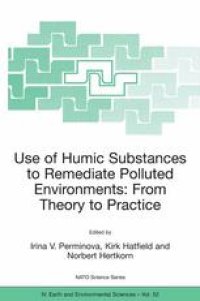
Ebook: Use of Humic Substances to Remediate Polluted Environments: From Theory to Practice: Proceedings of the NATO Advanced Research Workshop on Use of Humates to Remediate Polluted Environments: From Theory to Practice Zvenigorod, Russia 23–29 September 2002
- Tags: Ecotoxicology, Analytical Chemistry, Applied Microbiology, Geochemistry, Waste Water Technology / Water Pollution Control / Water Management / Aquatic Pollution
- Series: NATO Science Series 52
- Year: 2005
- Publisher: Springer Netherlands
- Edition: 1
- Language: English
- pdf
Effective remediation of polluted environments is a priority in both Eastern and Western countries. In the U.S. and Europe, remediation costs generally exceed the net economic value of the land. As a result, scientists and engineers on both sides of the Atlantic have aggressively tried to develop novel technologies to meet regulatory standards at a fraction of the costs. In situ remediation shows considerable promise from both technical and economic perspectives. In situ technologies that deploy natural attenuating agents such as humic substances (HS) may be even more cost effective. Numerous studies have shown humics capable of altering both the chemical and the physical speciation of the ecotoxicants and in turn attenuate potential adverse environmental repercussions. Furthermore, the reserves of inexpensive humic materials are immense. Which suggests HS portend great promise as inexpensive amendments to mitigate the environmental impacts of ecotoxicants and as active agents in remediation. To elucidate emerging concepts of humics-based remediation technologies, we organized the NATO Advanced Research Workshop (ARW), entitled "Use of humates to remediate polluted environments: from theory to practice", held on September 23-29, 2002 in Zvenigorod, Russia (see the web-site http://www.mgumus.chem.msu.ru/arw).
This is the first book aimed at the development of a common language among scientists working in the field of humic research and environmental engineers specialized in remediation technologies. In pursuing this goal, the engineer is provided with sufficient information on the basics and state of the art of humic research pertinent to remediation. For the interested scientist, this text provides sufficient information on the methods, needs, and limitations of existing remediation technologies, and on the latest developments in applied humic research. A novel approach is undertaken to categorizing the interactions encountered between humics, ecotoxicants, and living organisms in a polluted environment in the context of remediation chemistry. The volume pays particular attention to in situ remediation as the most viable option for the application of humics. The content of this book is of interest to scientists and engineers.